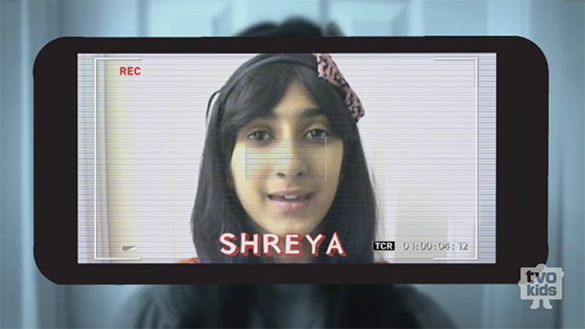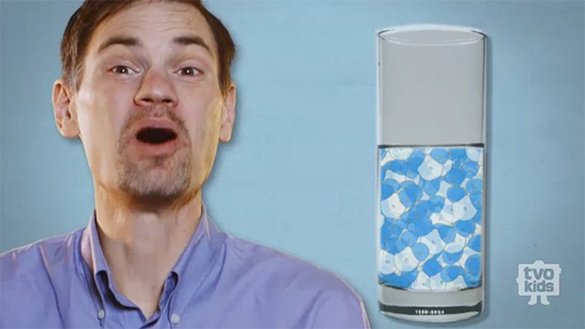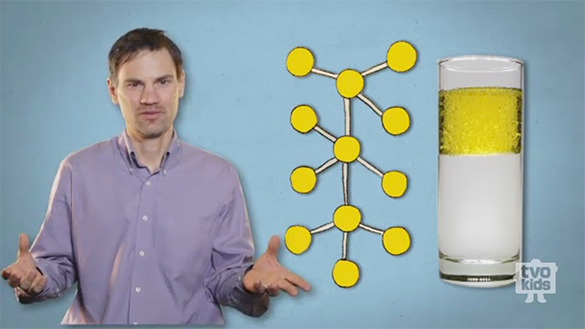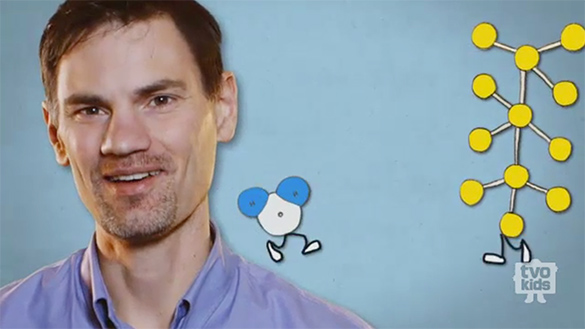Minds On
What is important?
Let’s explore a video where scientist Damian Pope answers the question “Why don’t oil and water mix?”
- What does the presenter do to capture your attention?
- What did you learn from the video?
Action
Presentation strategies

In an oral text, we can use different kinds of presentation and communication strategies to help share ideas and information. A presenter can also use these strategies to capture the attention of their audience throughout their presentation.
Some of the strategies include non-verbal cues. This means the presenter does not use their voice, but uses facial expressions, gestures, and eye contact to communicate with the audience.
Some of the strategies include vocal effects. This means that the presenter uses their voice and changes their tone, pace, pitch, and/or volume.
Presenters can also use visual aids and different types of words or vocabulary to help communicate their ideas.
Definitions of presentation strategies
Press the name of each presentation and communication strategy to access its definition.
Check the video that we explored in the Minds On section. What strategies did you notice that were used in this video? Complete the Presentation and Communication Strategies template in your notebook or using the following fillable activity document.

Press the Activity button to access Presentation and Communication Strategies.
Activity (Open PDF in a new tab)Press the following presentation and communication strategies to access examples that were used in the video.
Word choice: (vocal cue)
Scientist Damian Pope described why oil and water don’t mix by using science words like “molecules.” He also explained how water molecules and oil molecules are made by using the idea of a “jigsaw” or “puzzle pieces.”
Tone: (vocal cue)
At the beginning of the video, Shreya asks the question: “I wonder why oil and water do not mix?” Her tone goes up at the end of the question.

Pace: (vocal cue)
Damian presents his ideas using a medium pace. I was able to follow his presentation.
Volume: (vocal cue)
Damian kept his volume the same through his presentation. I was able to understand him clearly.
Facial expression: (non-verbal cues)
Damian changed his facial expressions throughout the presentation. When he expressed an interesting fact, he raised his eyebrows.

Gestures: (non-verbal cues)
Damian changed his gestures throughout the presentation.
When he explained an idea, he used his hands, and his expression was serious.

Eye contact: (non-verbal cues)
Damian made eye contact with the audience throughout his presentation.
Visual aids or props: (non-verbal cues)
Damian used cartoon images of water and oil molecules to show how they are made, and why they cannot fit together.

- Which presentation and communication strategies helped you understand the ideas in the video?
- What are some science questions you have for Damian Pope?
Consolidation
Identifying presentation strategies
Examine the following video where the presenter or narrator is off camera, and we explore the concepts visually with Eric. The video includes visuals, non-verbal, and vocal strategies.
After checking the video, identify the different presentation strategies used. You may complete the Presentation and Communication Strategies (1) chart in your notebook or using the following fillable document. You might choose to record an audio clip, discuss your ideas with a partner, or use another method of your choice.
Press the ‘Activity’ button to access Presentation and Communication Strategies.
Student Success
Think-Pair-Share
Working independently or with a partner, if possible, go through the examples you recorded and answer the following questions.
- What type of strategies did Eric use? Did they help you understand the ideas presented in this video?
- What types of strategies did the narrator (Vox) use? Did they help you understand the ideas presented in this video?
Note to teachers: See your teacher guide for collaboration tools, ideas and suggestions.
Compare and contrast

Reflect on the two videos in this learning activity. What are some similarities and differences between the ideas in the Minds On video and the Consolidation video? Do the presenters use similar strategies?
What kinds of presentation and communication strategies would you use in your future presentations?
Reflection
As you read through these descriptions, which sentence best describes how you are feeling about your understanding of this learning activity? Press the button that is beside this sentence.
I feel…
Now, record your ideas using a voice recorder, speech-to-text, or writing tool.